An Alternative Approach to Measure Co-Movement between Two Time Series
Abstract
1. Introduction
2. Introducing the HP of Two Series
2.1. Hurst Exponent of a Time Series
2.2. HP
2.2.1. Correlated Series
2.2.2. Cointegrated Series
2.2.3. Uncorrelated Series
2.2.4. Nonlinear Relationship
2.2.5. Copula Relationship
3. Testing HP in Financial Series
3.1. Paris Trading: Strategy Definition and Application
- First, the prices are normalized as defined by Ramos-Requena et al. (2017) [62]. Therefore, for a pair of stocks A and B, for each dollar invested in A we will invest b dollars in B, where b is given by , and (resp. ) is the log-return of A (resp. B).The series of the pair is defined such that its increments are given by .
- Pairs selection:To select the pairs, the correlation method is chosen by using Pearson’s correlation method and through the HP method, as it was explained in Section 2.2. The duration of this phase will be 250 or 500 days, as we will indicate later.
- Trading strategy (see Ramos-Requena et al. (2017) [62] for a more detailed description):
- When the pair is sold. The position is closed when or .
- When the pair is bought. The position is closed when or .
where m is a moving average of the series of the pair and s is a moving standard deviation of m.
- HP: daily returns are used.
- HP1: 10 days (2 weeks) returns are chosen.
- HP2: 20 days (4 weeks) returns are chosen and the selection period is 500 days (around 2 years).
3.2. HP
3.3. HP1
3.4. HP2
4. Conclusions
Author Contributions
Funding
Acknowledgments
Conflicts of Interest
References
- Markowitz, H. Portfolio Selection. J. Financ. 1952, 7, 77–91. [Google Scholar]
- Roy, A. Safety first and the holding of assets. Econometrica 1952, 20, 431–449. [Google Scholar] [CrossRef]
- Mizuno, T.; Takayasu, H.; Takayasu, M. Correlation networks among currencies. Phys. A Stat. Mech. Its Appl. 2006, 364, 336–342. [Google Scholar] [CrossRef]
- He, L.Y.; Chen, S.P. Multifractal detrended cross-correlation analysis of agricultural futures markets. Chaos Solitons Fractals 2001, 44, 355–361. [Google Scholar] [CrossRef]
- Shiller, R.J.; Beltratti, A.E. Stock prices and bond yields. J. Monet. Econ. 1992, 30, 25–46. [Google Scholar] [CrossRef]
- Gulko, L. Decoupling. J. Portf. Manag. 2002, 28, 59–67. [Google Scholar] [CrossRef]
- Cappiello, L.; Engle, R.F.; Sheppard, K. Asymmetric dynamics in the correlations of global equity and bond returns. J. Financ. Econom. 2006, 4, 537–572. [Google Scholar] [CrossRef]
- Andersson, M.; Krylova, E.; Vähämaa, S. Why does the correlation between stock and bond returns vary over time? Appl. Financ. Econ. 2008, 18, 139–151. [Google Scholar] [CrossRef]
- Lin, W.L.; Engle, R.F.; Ito, T. Do bulls and bears move across borders? International transmission of stock returns and volatility. Rev. Financ. Stud. 1994, 7, 507–538. [Google Scholar] [CrossRef]
- Erb, C.B.; Harvey, C.R.; Viskanta, T.E. Forecasting international correlation. Financ. Anal. J. 1994, 50, 32–45. [Google Scholar] [CrossRef]
- Longinand, F.; Solnik, B. Is the correlation in international equity returns constant: 1960–1990? J. Int. Money Financ. 1995, 14, 3–26. [Google Scholar] [CrossRef]
- Karolyi, G.A.; Stulz, R.M. Why do markets move together? An investigation of U.S.-Japan stock return co-movement. J. Financ. 1996, 51, 951–986. [Google Scholar] [CrossRef]
- De Santis, G.; Gerard, B. International asset pricing and portfolio diversification with time-varying risk. J. Financ. 1997, 52, 1881–1912. [Google Scholar] [CrossRef]
- Ramchand, L.; Susmel, R. Volatility and cross correlation across major stock markets. J. Empir. Financ. 1998, 5, 397–416. [Google Scholar] [CrossRef]
- Solnik, B.; Boucrelle, C.; Le Fur, Y. International market correlation and volatility. Financ. Anal. J. 1996, 52, 17–34. [Google Scholar] [CrossRef]
- Engle, R. Dynamic conditional correlation: A simple class of multivariate generalized autoregressive conditional heteroskedasticity models. J. Bus. Econ. Stat. 2002, 20, 339–350. [Google Scholar] [CrossRef]
- Campbell, R.; Koedijk, K.; Kofman, P. Increased correlation in bear markets. Financ. Anal. J. 2002, 58, 87. [Google Scholar] [CrossRef]
- Jain, P.; Xue, W. Global Investigation of Return Autocorrelation and its Determinants. Pac-Basin Financ. J. 2017, 43, 200–217. [Google Scholar] [CrossRef][Green Version]
- Gopikrishnan, P.; Plerou, V.; Liu, Y.; Amaral, L.N.; Gabaix, X.; Stanley, H.E. Scaling and correlation in financial time series. Phys. A Stat. Mech. Its Appl. 2000, 287, 362–373. [Google Scholar] [CrossRef]
- Engle, R.F. Autoregressive conditional heteroscedasticity with estimates of the variance of United Kingdom inflation. Econometrica 1982, 50, 987–1007. [Google Scholar] [CrossRef]
- Baillie, R.T.; Bollerslev, T. Intra-day and inter-market volatility in foreign exchange rates. Rev. Econ. Stud. 1991, 58, 565–585. [Google Scholar] [CrossRef]
- Nelson, D.B. Conditional heteroskedasticity in asset returns: A new approach. Econometrica 1991, 59, 347–370. [Google Scholar] [CrossRef]
- Hamilton, J.D.; Susmel, R. Autoregressive conditional heteroskedasticity and changes in regime. J. Econom. 1994, 64, 307–333. [Google Scholar] [CrossRef]
- Cai, J. A Markov model of unconditional variance in ARCH. J. Bus. Econ. Stat. 1994, 12, 309–316. [Google Scholar]
- Ding, Z.; Granger, C.W. Modeling volatility persistence of speculative returns: A new approach. J. Econom. 1996, 73, 185–215. [Google Scholar] [CrossRef]
- Hafner, C.M.; Franses, P.H. A generalized dynamic conditional correlation model: Simulation and application to many assets. Econom. Rev. 2009, 28, 612–631. [Google Scholar] [CrossRef]
- Hurst, H. Long term storage capacity of reservoirs. Trans. Am. Soc. Civ. Eng. 1951, 6, 770–799. [Google Scholar]
- López-García, M.N.; Ramos-Requena, J.P. Different methodologies and uses of the Hurst exponent in econophysics. Estud. Econ. Appl. 2009, 37, 96–108. [Google Scholar] [CrossRef]
- Tatl, H. Detecting persistence of meteorological drought via the Hurst exponent. Meteorol. Appl. 2015, 22, 763–769. [Google Scholar] [CrossRef]
- Singh, A.K.; Bhargawa, A. An early prediction of 25th solar cycle using Hurst exponent. Astrophys. Space Sci. 2017, 362, 199. [Google Scholar] [CrossRef]
- Tong, S.; Zhang, J.; Bao, Y.; Lai, Q.; Lian, X.; Li, N.; Bao, Y. Analyzing vegetation dynamic trend on the Mongolian Plateau based on the Hurst exponent and influencing factors from 1982–2013. J. Geogr. Sci. 2018, 28, 595–610. [Google Scholar] [CrossRef]
- Witton, C.; Sergeyev, S.V.; Turitsyna, E.G.; Furlong, P.L.; Seri, S.; Brookes, M.; Turitsyn, S.K. Rogue bioelectrical waves in the brain: The Hurst exponent as a potential measure for presurgical mapping in epilepsy. J. Neural Eng. 2019, 16, 056019. [Google Scholar] [CrossRef] [PubMed]
- Gao, J.; Hu, J.; Mao, X.; Perc, M. Culturomics meets random fractal theory: Insights into long-range correlations of social and natural phenomena over the past two centuries. J. R. Soc. Interface 2012, 9, 1956–1964. [Google Scholar] [CrossRef] [PubMed]
- Mandelbrot, B.; Wallis, J.R. Robustness of the rescaled range R/S in the measurement of noncyclic long-run statistical dependence. Water Resour. Res. 1969, 5, 967–988. [Google Scholar] [CrossRef]
- Lo, A.W. Long-term memory in stock market prices. Econometrica 1991, 59, 1279–1313. [Google Scholar] [CrossRef]
- Sánchez-Granero, M.A.; Trinida-Segovia, J.E.; García-Pérez, J. Some comments on Hurst exponent and the long memory processes on capital markets. Phys. A Stat. Mech. Its Appl. 2008, 387, 5543–5551. [Google Scholar] [CrossRef]
- Weron, R. Estimating long-range dependence finite sample properties and confidence intervals. Phys. A Stat. Mech. Its Appl. 2002, 312, 285–299. [Google Scholar] [CrossRef]
- Willinger, W.; Taqqu, M.S.; Teverovsky, V. Stock market prices and long-range dependence. Financ. Stoch. 1999, 3, 1–13. [Google Scholar] [CrossRef]
- Sánchez-Granero, M.A.; Trinidad-Segovia, J.E.; García-Pérez, J.; Fernández-Martínez, M. The effect of the underlying distribution in Hurst exponent estimation. PLoS ONE 2015, 10, e0127824. [Google Scholar]
- Geweke, J.; Porter-Hudak, S. The estimation and application of long memory time series models. J. Time Ser. Anal. 1983, 4, 221–238. [Google Scholar] [CrossRef]
- Haslett, J.; Raftery, A.E. Space time modelling with long memory dependence: Assessing Irelands wind power resource. J. R. Stat. Soc. Ser. C (Appl. Stat.) 1989, 38, 1–50. [Google Scholar] [CrossRef]
- Barabasi, A.L.; Vicsek, T. Multifractality of self affine fractals. Phys. Rev. A 1991, 44, 2730–2733. [Google Scholar] [CrossRef] [PubMed]
- Veitch, D.; Abry, P. A wavelet-based joint estimator of the parameters of long-range dependence. IEEE Trans. Inf. Theory 1999, 45, 878–897. [Google Scholar] [CrossRef]
- Alessio, E.; Carbone, A.; Castelli, G.; Frappietro, V. Second-order moving average and scaling of stochastic time series. Eur. Phys. J. B-Condens. Matter Complex Syst. 2002, 27, 197–200. [Google Scholar] [CrossRef]
- Kantelhardt, J.W.; Zschiegner, S.A.; Koscielny-Bunde, E.; Havlin, S.; Bunde, A.; Stanley, H.E. Multifractal detrended fluctuation analysis of nonstationary time series. Phys. A Stat. Mech. Its Appl. 2002, 316, 87–114. [Google Scholar] [CrossRef]
- Bensaida, A. Noisy chaos in intraday financial data: Evidence from the American index. Appl. Math. Comput. 2014, 226, 258–265. [Google Scholar] [CrossRef]
- Das, A.; Das, P. Does composite index of NYSE represents chaos in the long time scale? Appl. Math. Comput. 2006, 174, 483–489. [Google Scholar] [CrossRef]
- Sánchez-Granero, M.A.; Fernández-Martínez, M.; Trinidad-Segovia, J.E. Introducing fractal dimension algorithms to calculate the Hurst exponent of financial time series. Eur. Phys. J. B 2012, 85, 86. [Google Scholar] [CrossRef]
- Fernández-Martínez, M.; Sánchez-Granero, M.A.; Trinidad-Segovia, J.E. Measuring the self-similarity exponent in Levy stable processes of financial time series. Phys. A Stat. Mech. Its Appl. 2013, 392, 5330–5345. [Google Scholar] [CrossRef]
- Barunik, J.; Kristoufek, L. On Hurst exponent estimation under heavy-tailed distributions. Phys. A Stat. Mech. Its Appl. 2010, 389, 3844–3855. [Google Scholar] [CrossRef]
- Embrechts, P.; McNeil, A.J.; Straumann, D. Correlation: Pitfalls and alternatives. Risk 1999, 12, 69–71. [Google Scholar]
- Aas, J. Pair-Copula Constructions for Financial Applications: A Review. Econometrics 2016, 4, 43. [Google Scholar] [CrossRef]
- Joe, H. Families of m-variate distributions with given margins and bivariate dependence parameters. In Distributions with Fixed Marginals and Related Topics; Lecture Notes-Monograph Series, 28; Institute of Mathematical Statistics: Hayward, CA, USA, 1996; pp. 120–141. [Google Scholar]
- Bedford, T.; Cooke, R.M. Probability density decomposition for conditionally dependent random variables modeled by vines. Ann. Math. Artif. Intell. 2001, 32, 245–268. [Google Scholar] [CrossRef]
- Bedford, T.; Cooke, R.M. Vines: A new graphical model for dependent random variables. Ann. Stat. 2002, 30, 1031–1068. [Google Scholar] [CrossRef]
- Aas, K.; Czado, C.; Frigessi, A.; Bakken, H. Pair-copula constructions of multiple dependence. Insur. Math. Econ. 2009, 44, 182–198. [Google Scholar] [CrossRef]
- Czado, C. Analyzing Dependent Data with Vine Copulas; Lecture Notes in Statistics; Springer: Berlin, Germany, 2019. [Google Scholar]
- Pizzutilo, F. A note on the effectiveness of pairs trading for individual investors. Int. J. Econ. Financ. Issues 2013, 3, 763–771. [Google Scholar]
- Vidyamurthy, G. Pairs Trading: Quantitative Methods and Analysis; John Wiley and Sons: Hoboken, NJ, USA, 2004. [Google Scholar]
- Gatev, E.; Goetzmann, W.; Rouwenhorst, K. Pairs trading: Performance of a relative value arbitrage rule. Rev. Financ. Stud. 2006, 19, 797–827. [Google Scholar] [CrossRef]
- Liew, R.Q.; Wu, Y. Pairs trading: A copula approach. J. Deriv. Hedge Funds 2013, 19, 12–30. [Google Scholar] [CrossRef]
- Ramos-Requena, J.P.; Trinidad-Segovia, J.E.; Sánchez-Granero, M.A. Introducing Hurst exponent in pair trading. Phys. A Stat. Mech. Its Appl. 2017, 488, 39–45. [Google Scholar] [CrossRef]

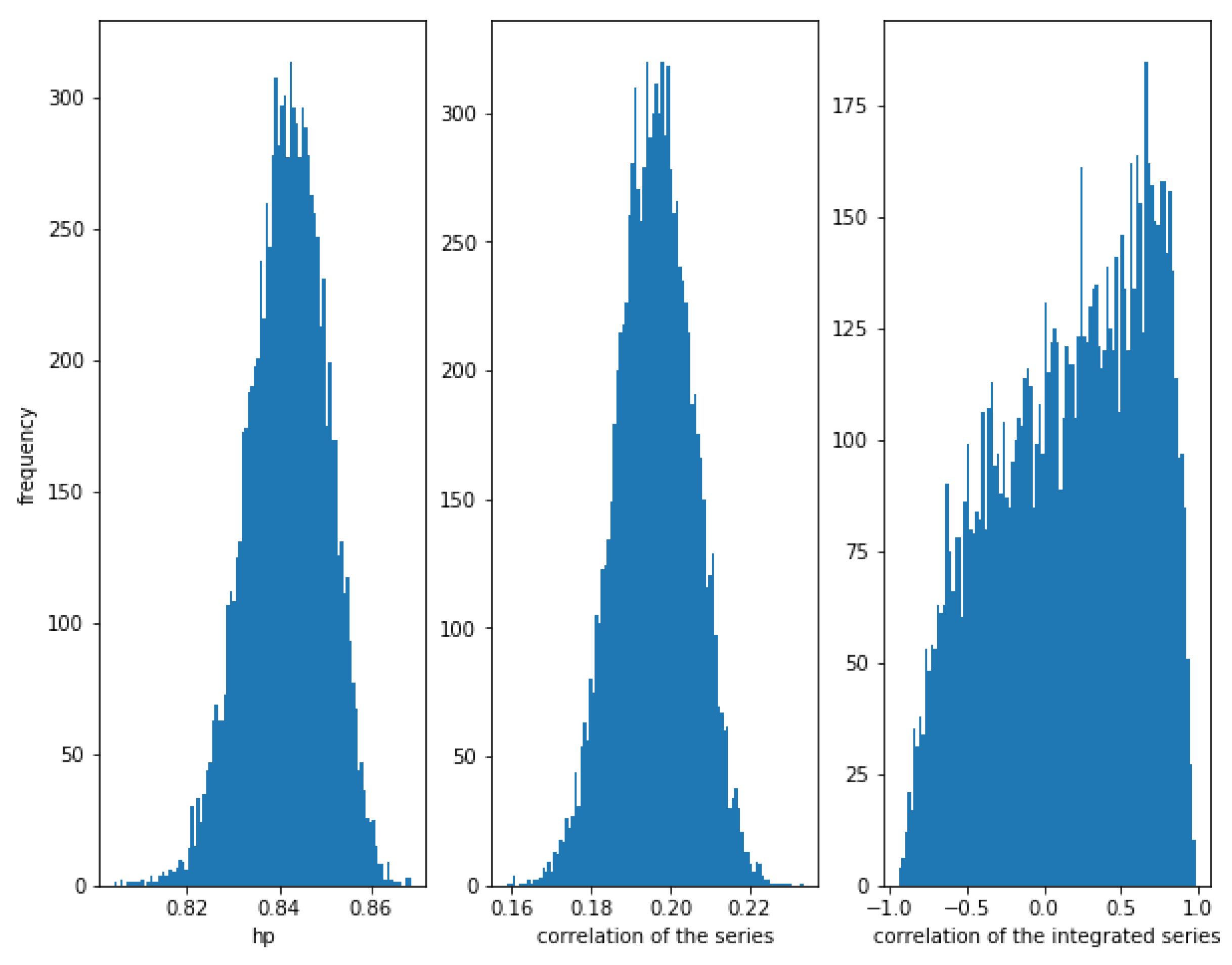
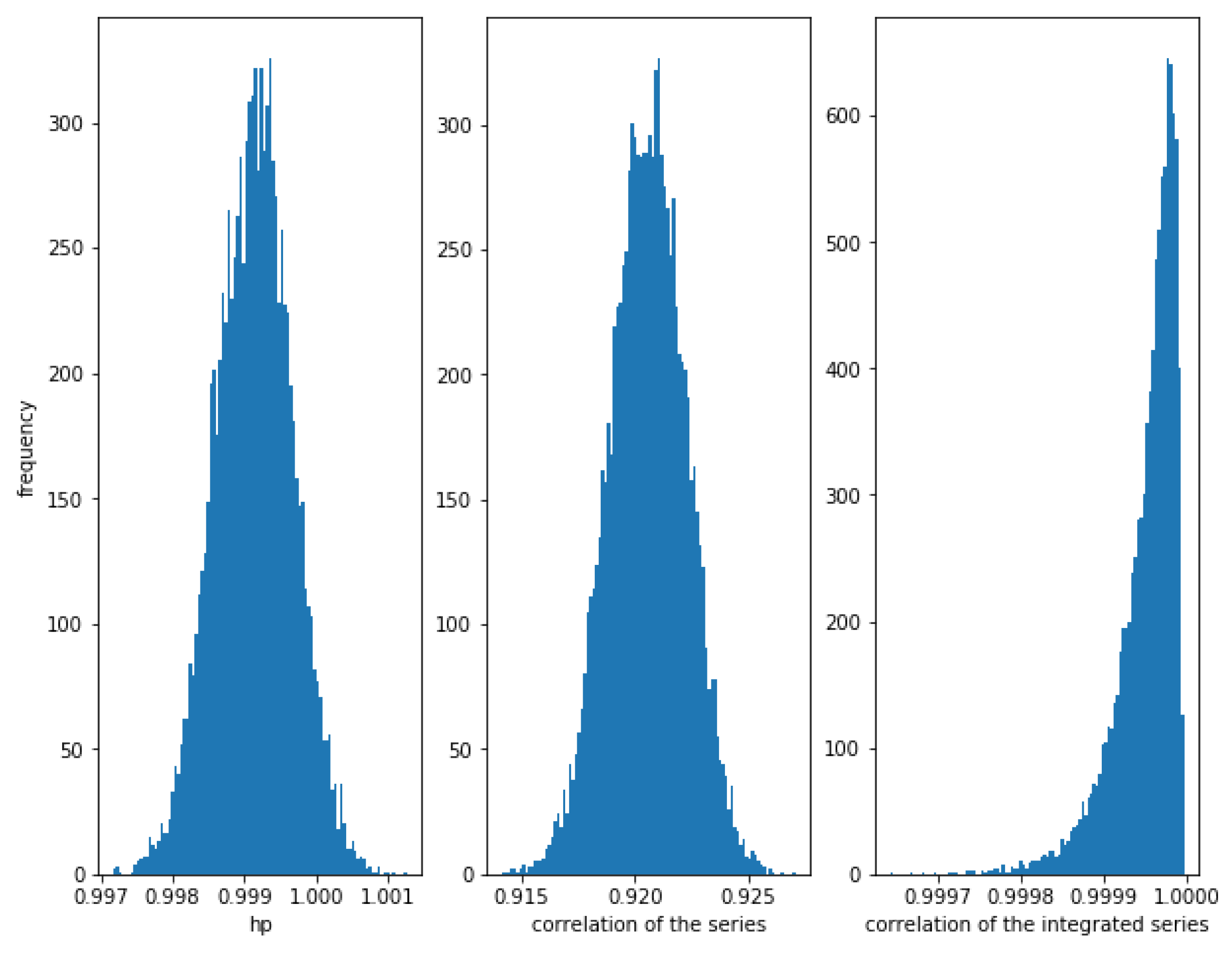
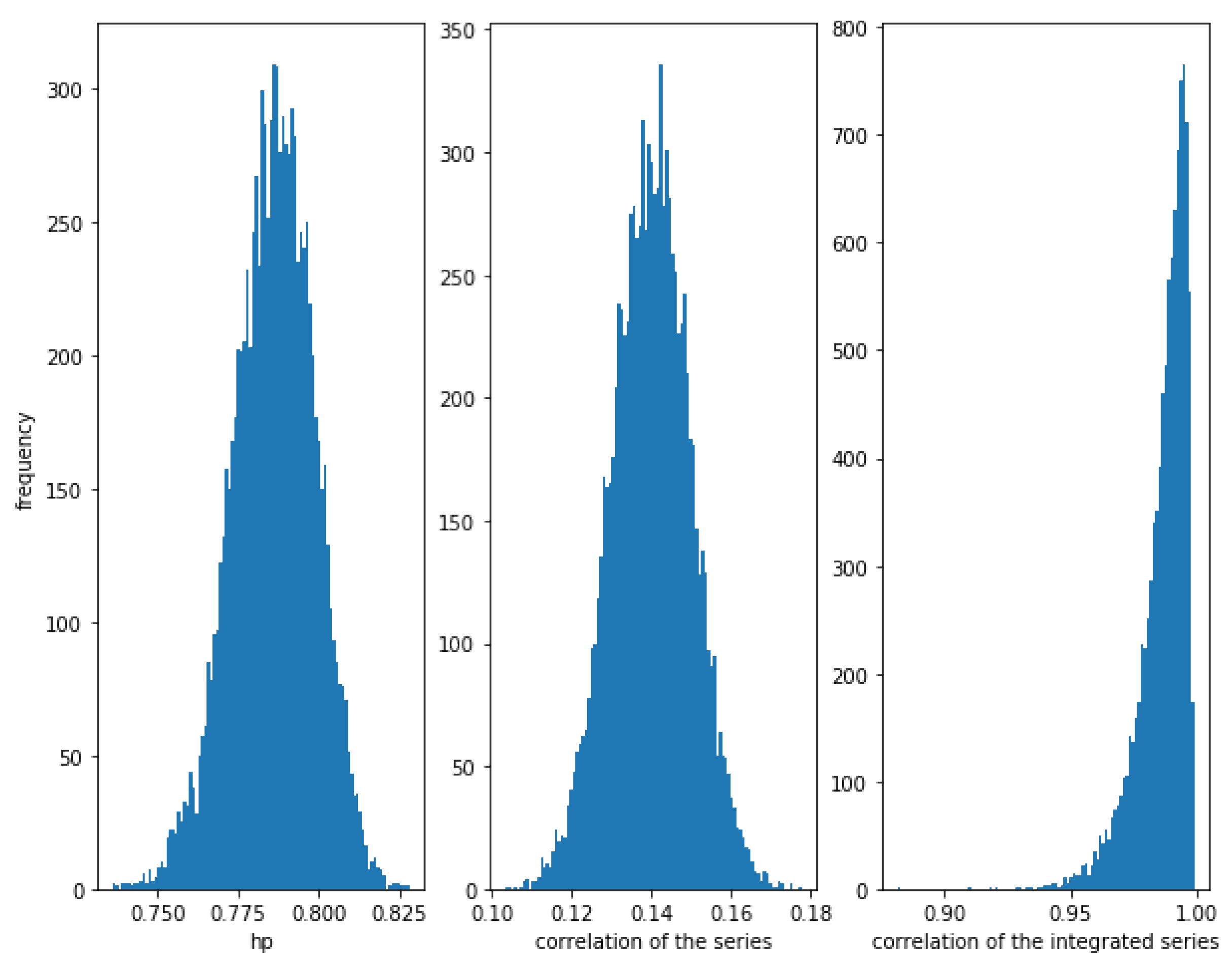

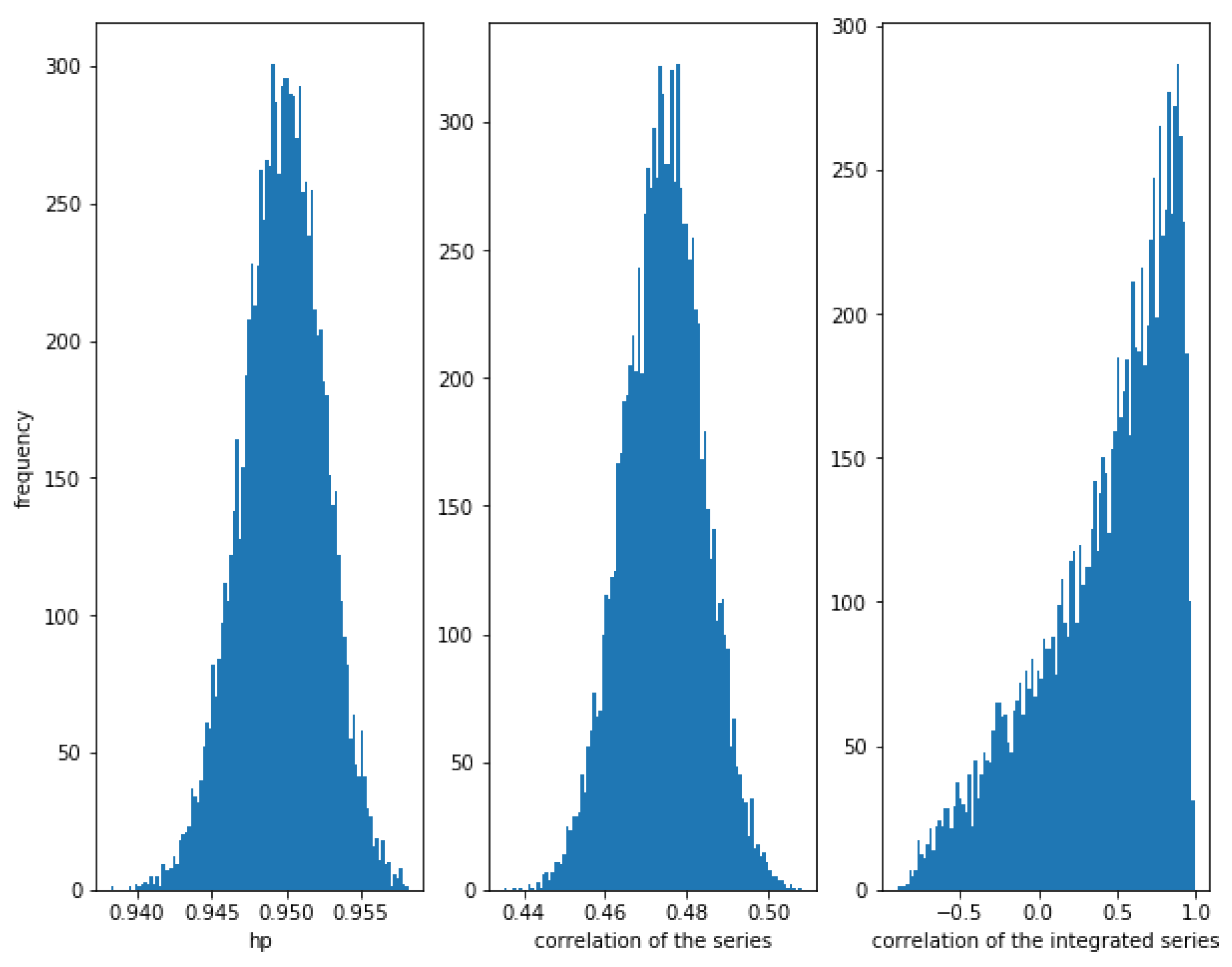
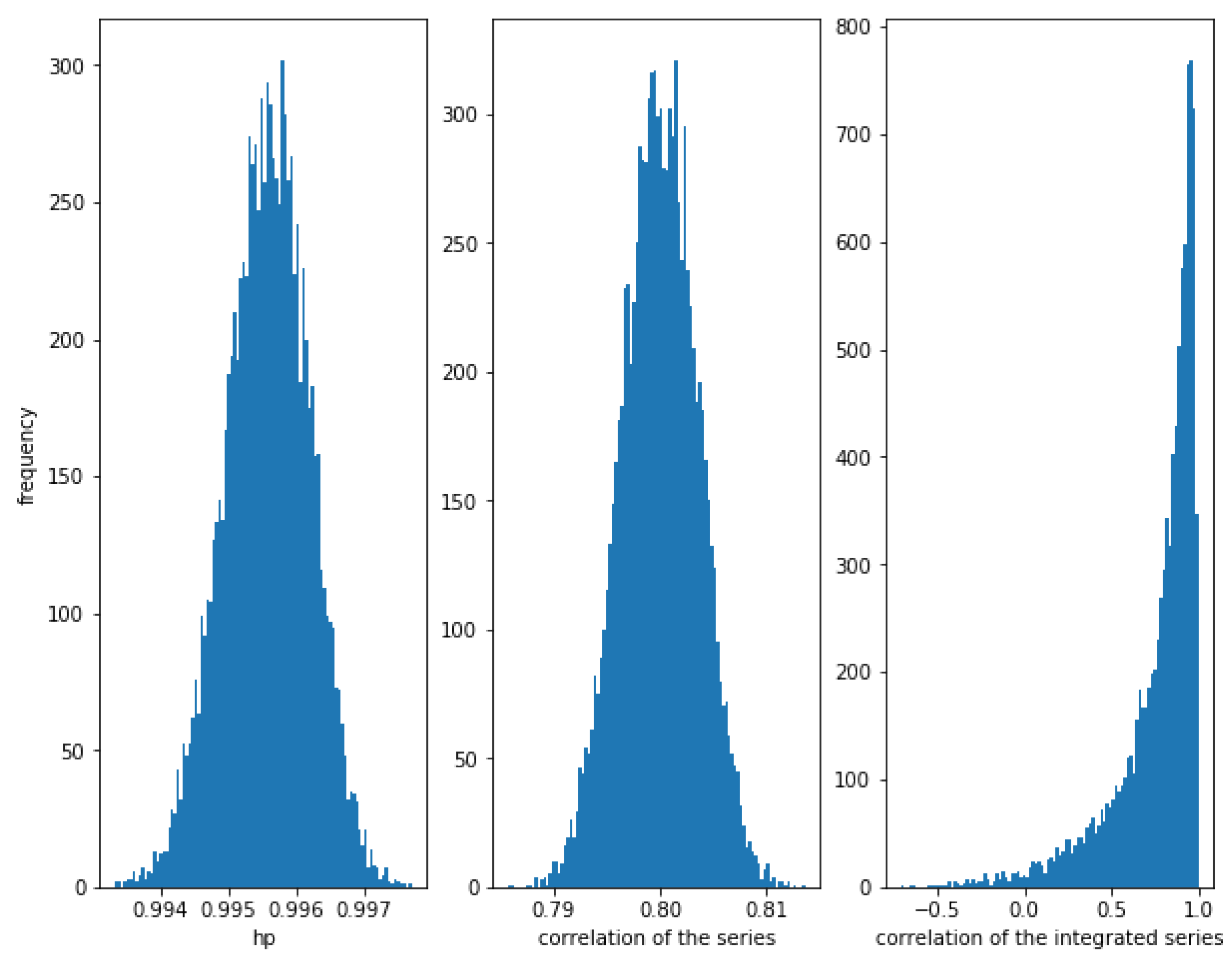
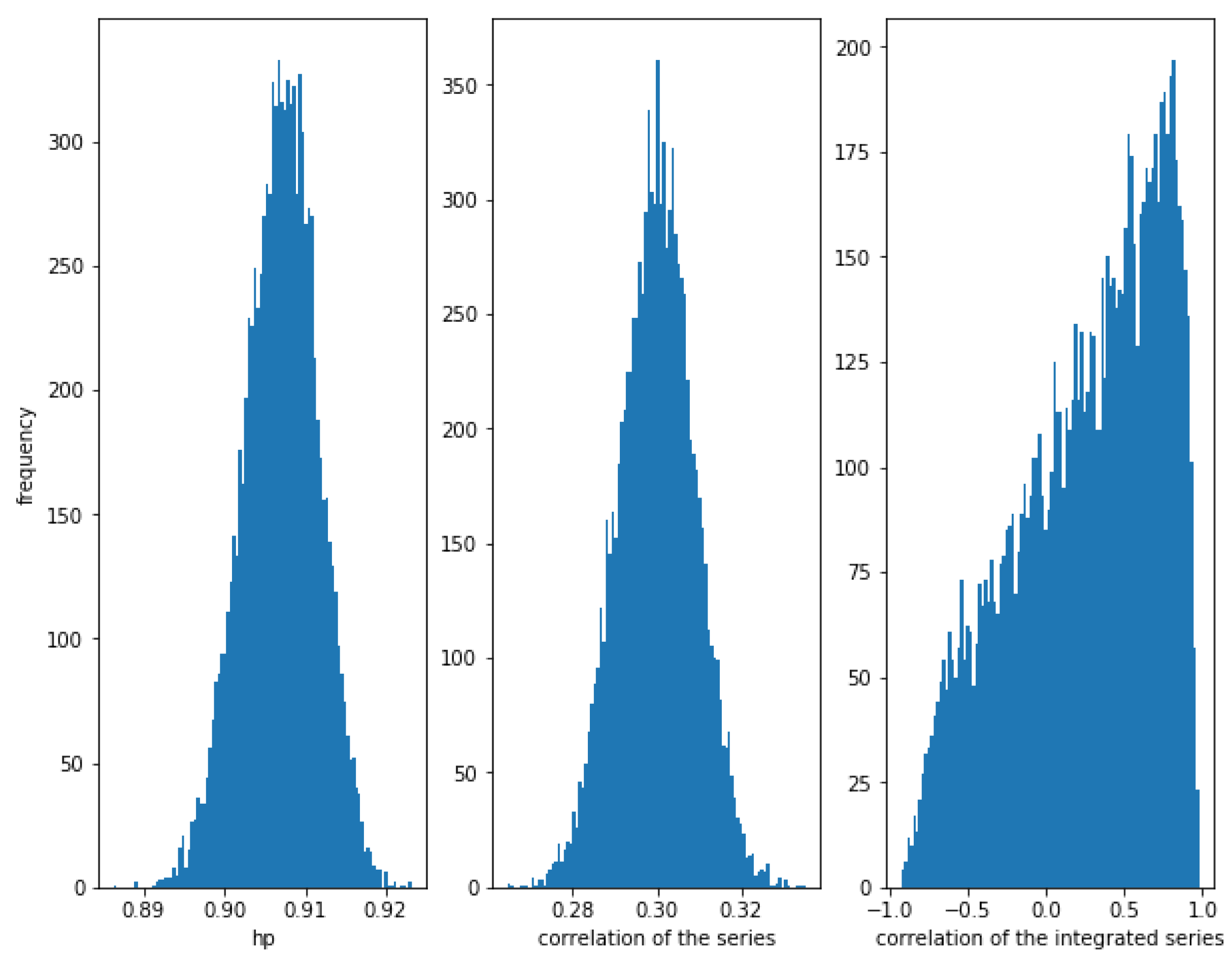
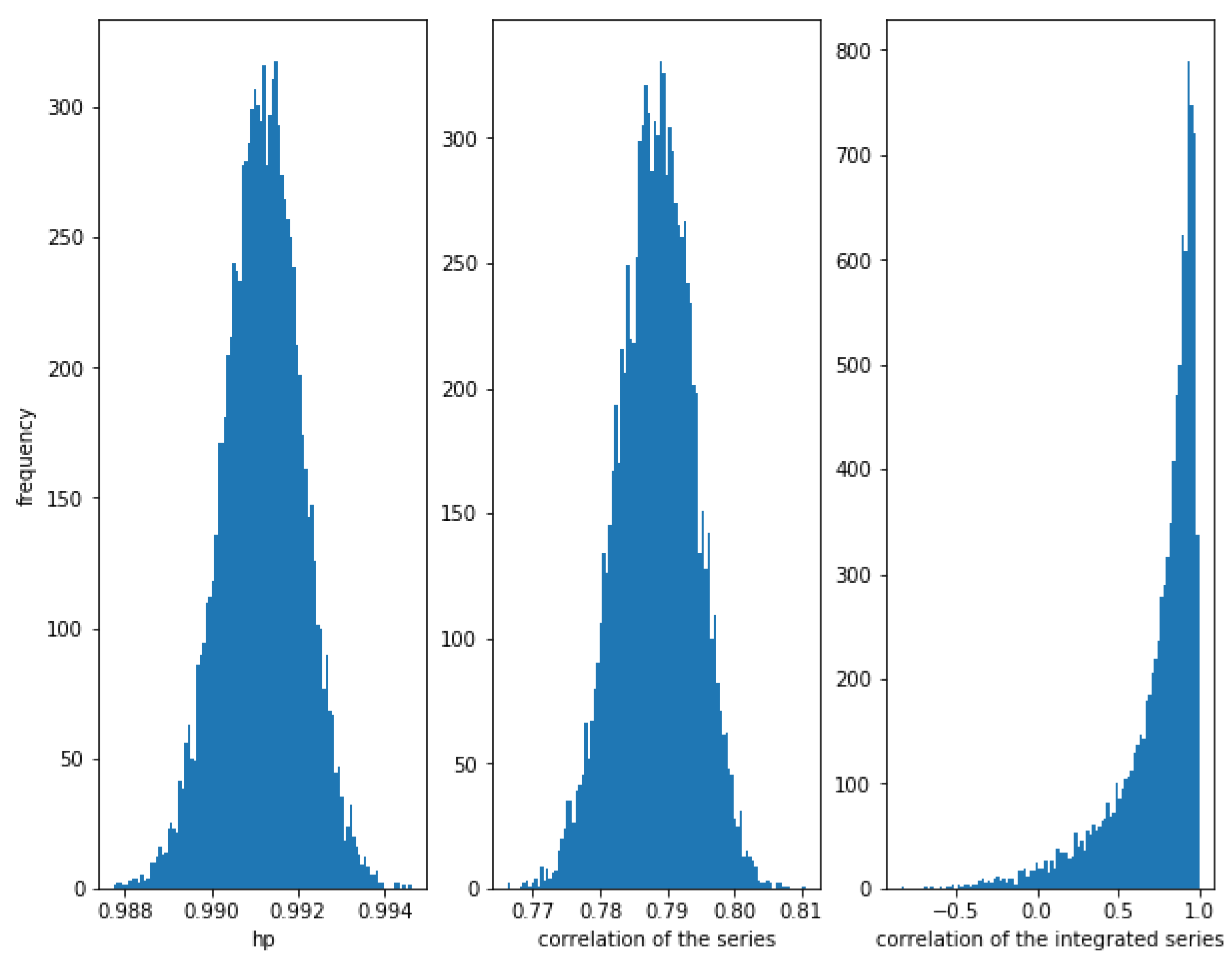

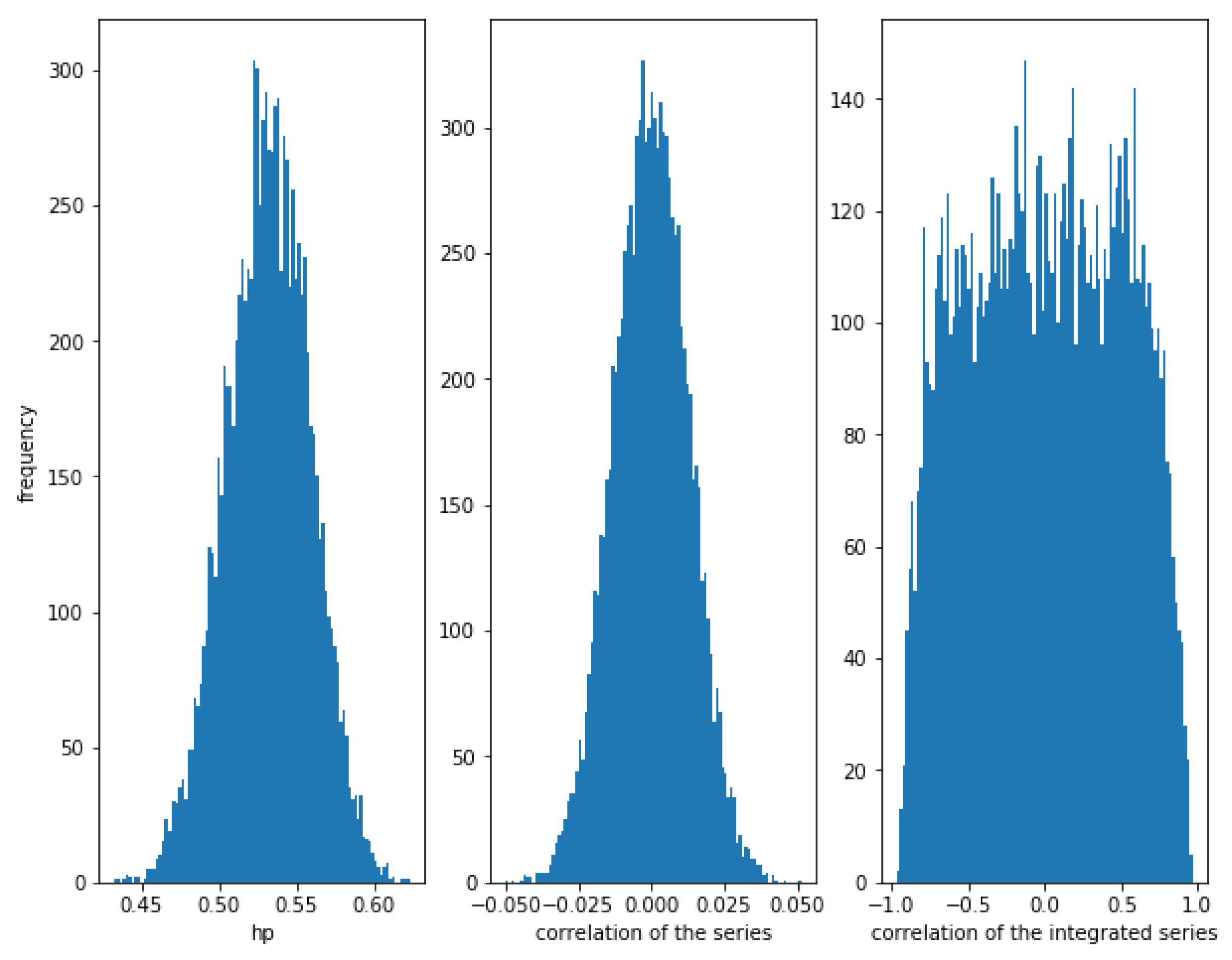
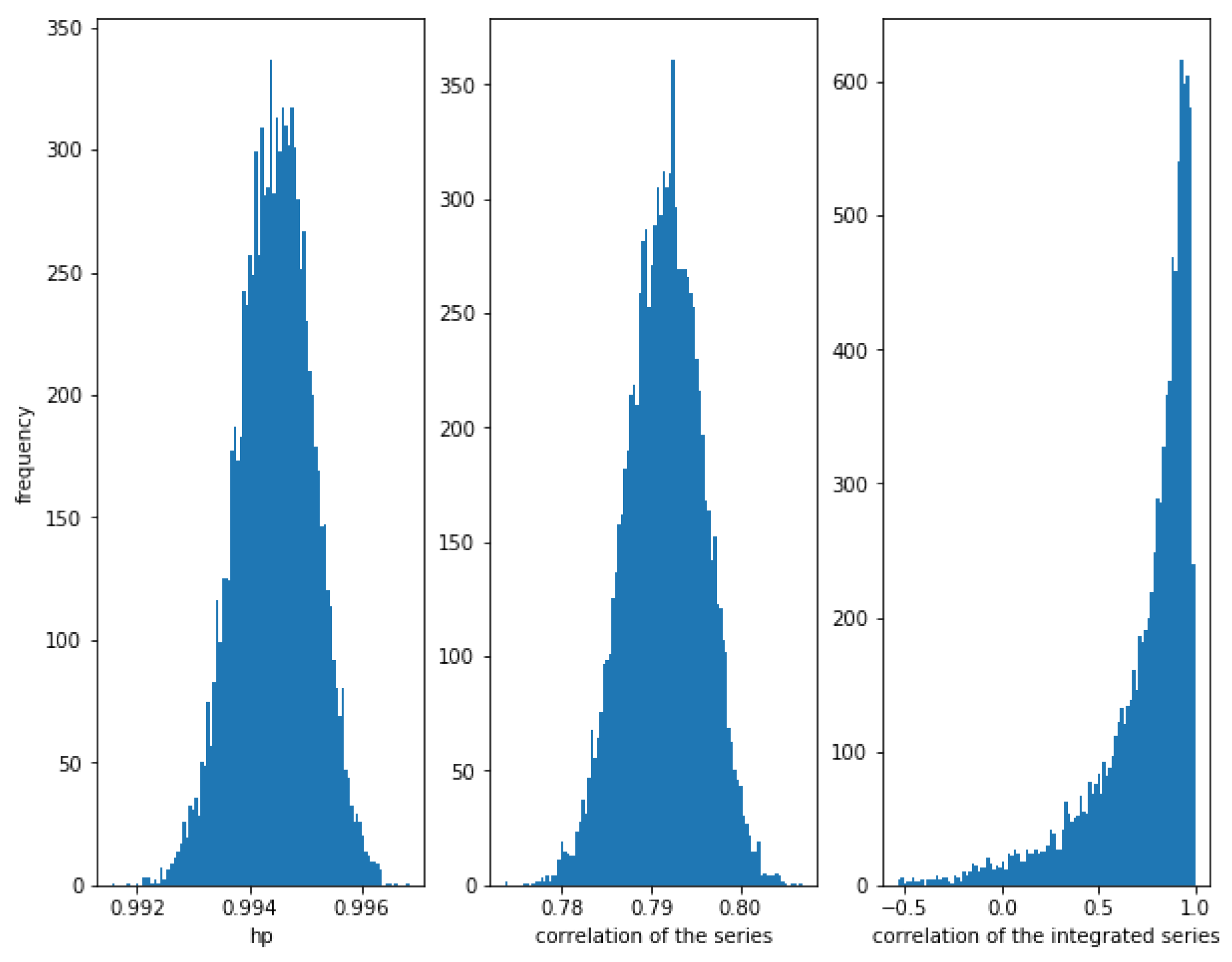
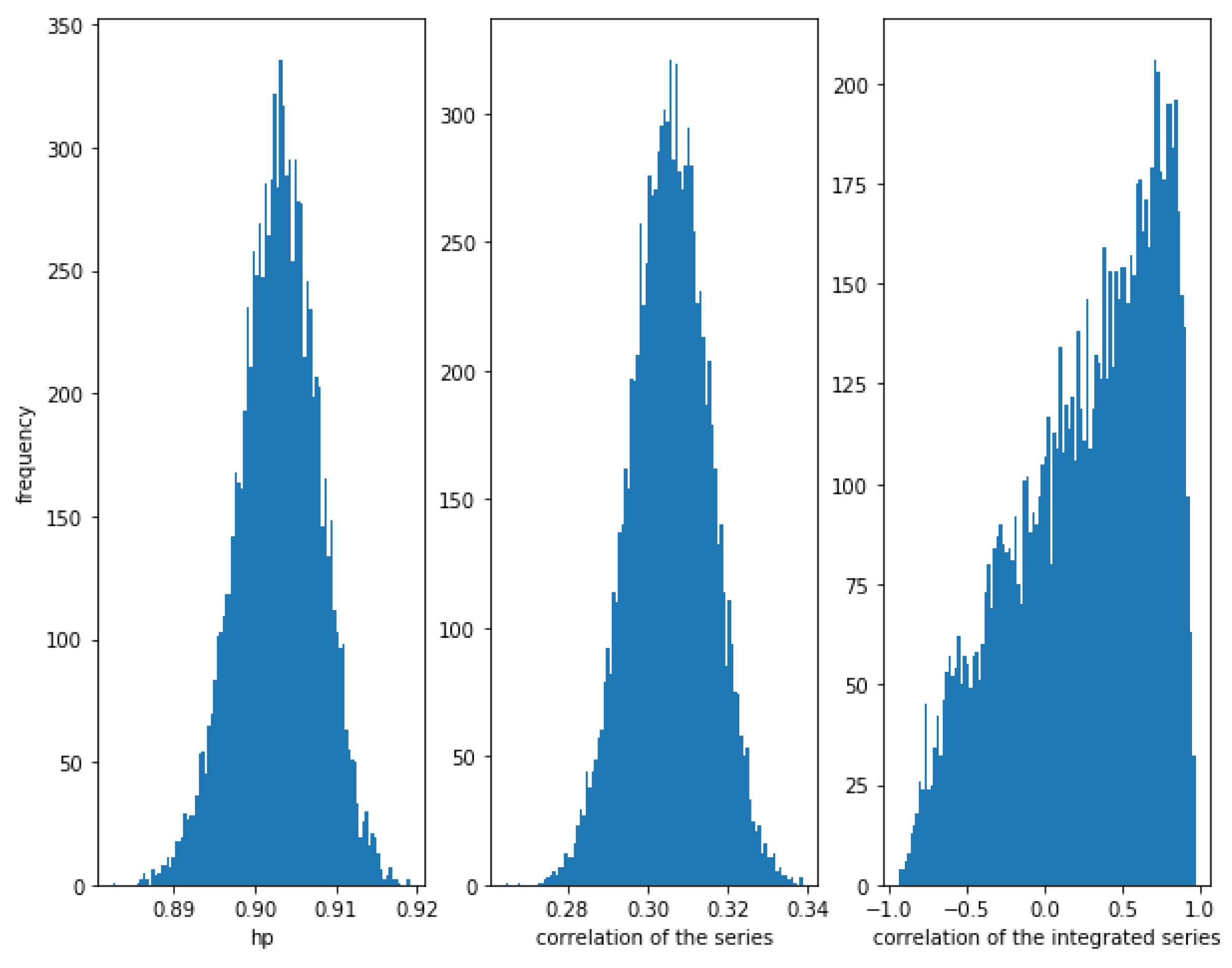

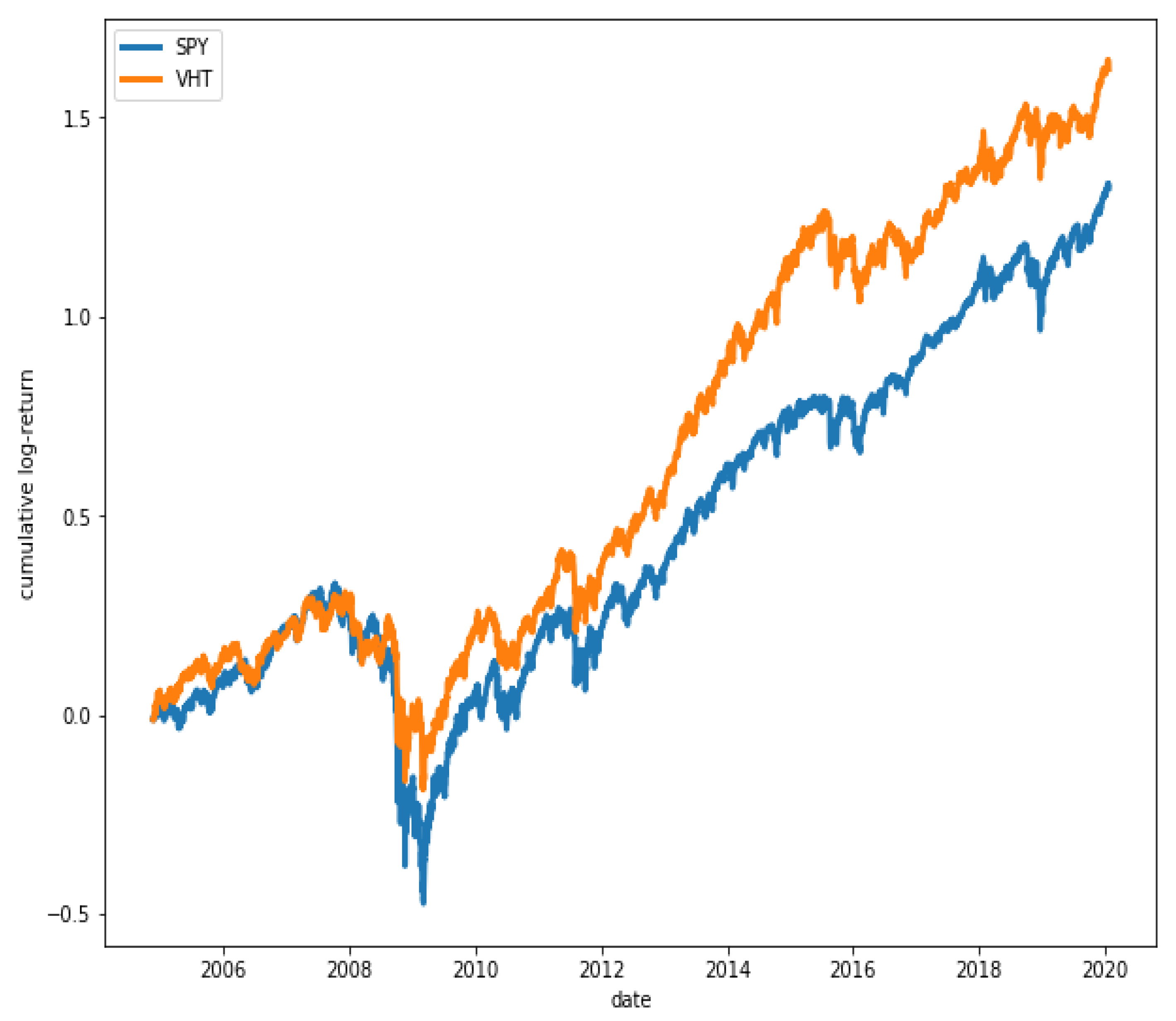


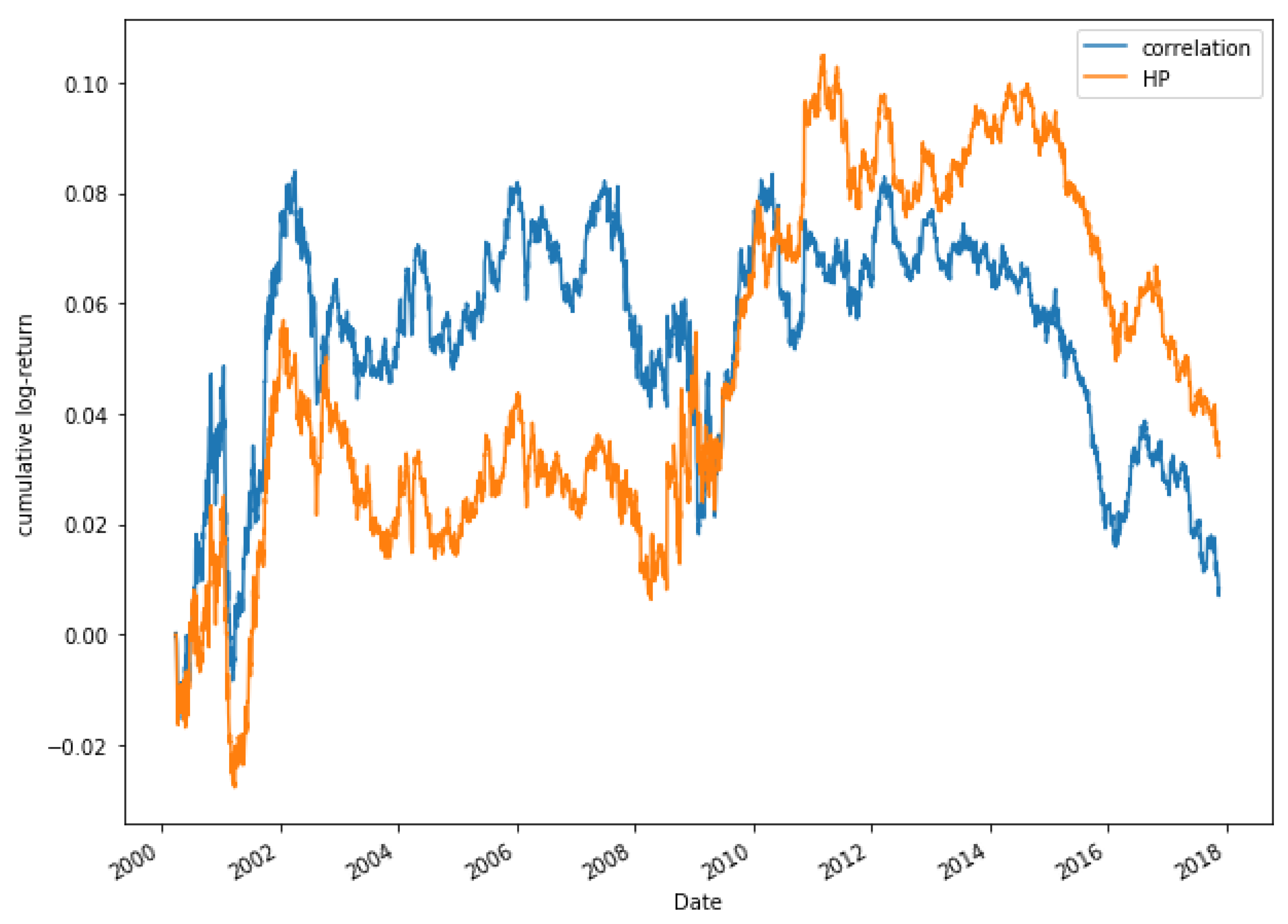
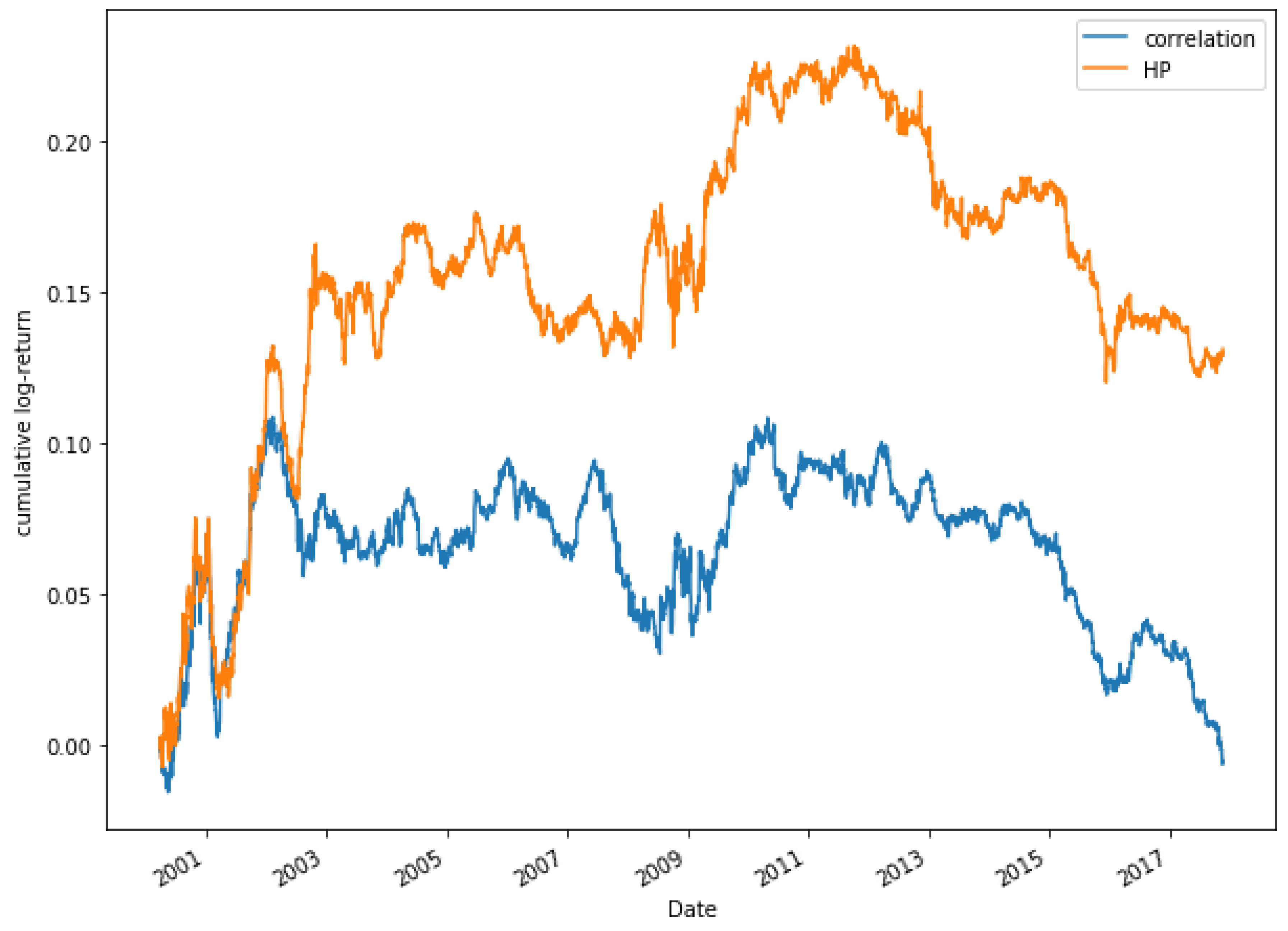
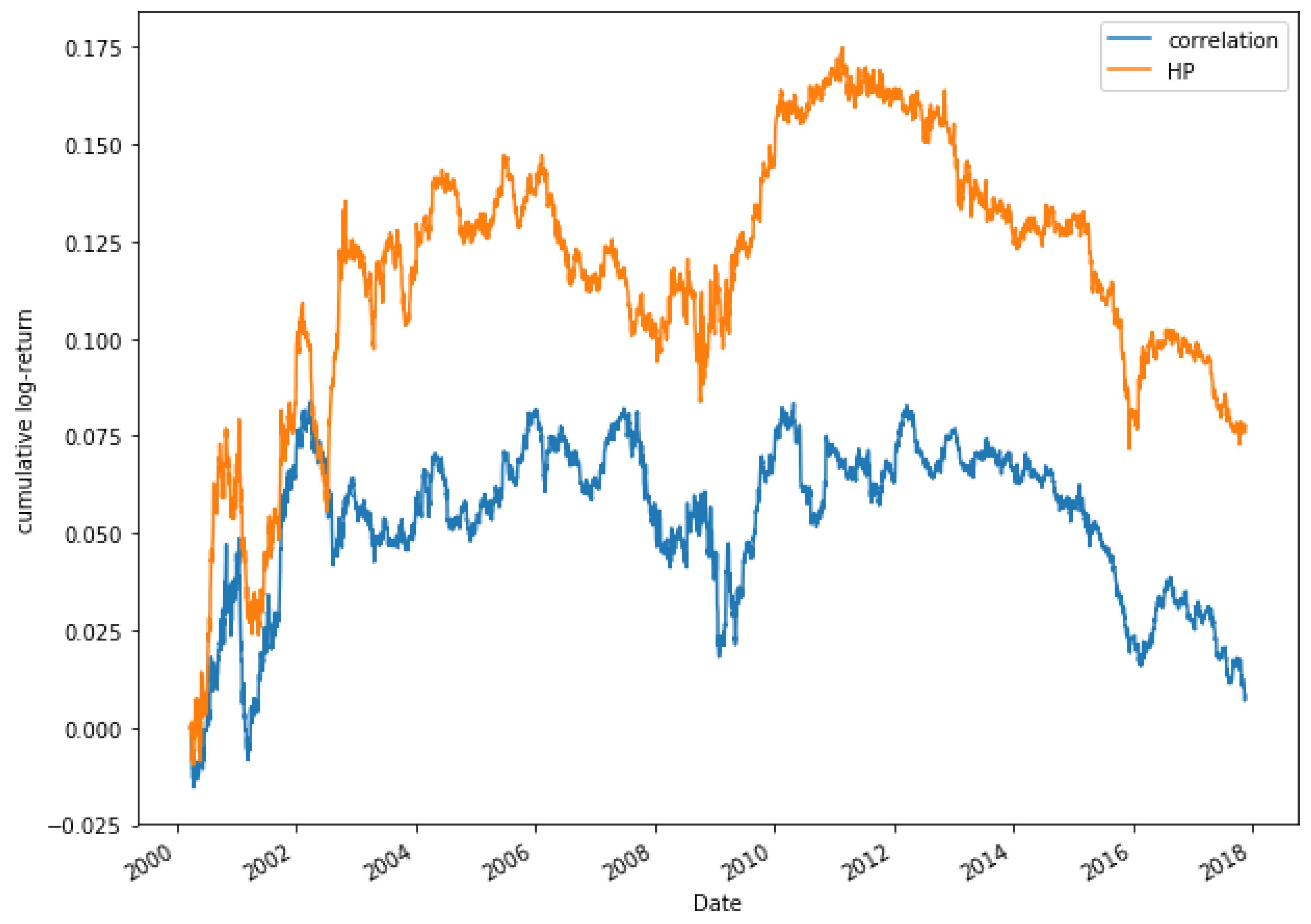

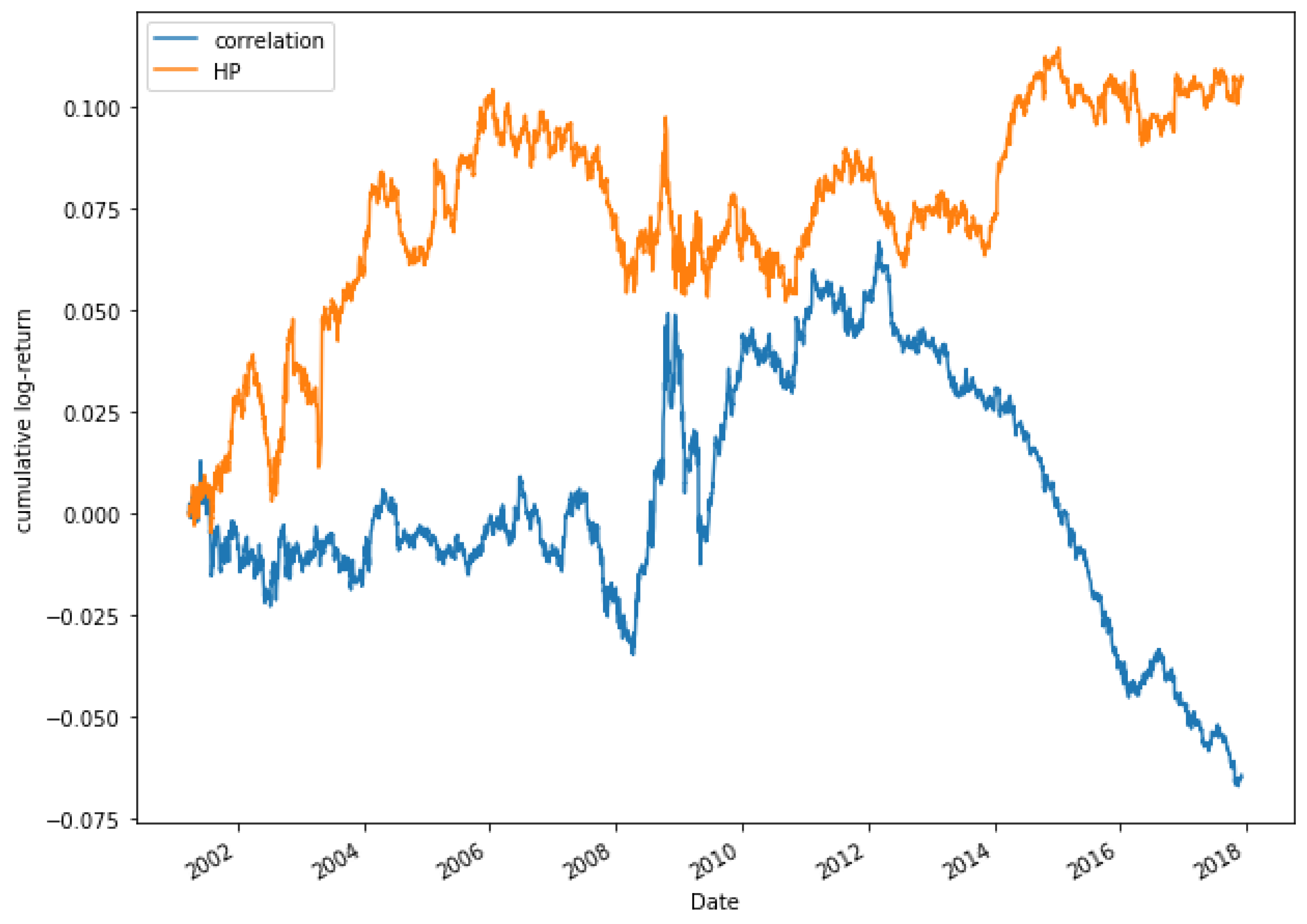

| Method | N | AAV | Sharpe R | % Max Drawdonw | % Profit |
|---|---|---|---|---|---|
| Correlation | 2 | 0.50% | 0.12 | 12.30% | 6.20% |
| HP | 2 | 0.30% | 0.05 | 13.40% | 1.20% |
| Correlation | 5 | 0.30% | 0.70 | 18.30% | 1.27% |
| HP | 5 | 1.00% | 0.28 | 9.40% | 16.30% |
| Correlation | 10 | 0.00% | −0.01 | 9.80% | −4.41% |
| HP | 10 | 0.20% | 0.07 | 10.90% | −0.04% |
| Correlation | 15 | 0.00% | −0.01 | 10.90% | −4.25% |
| HP | 15 | 0.60% | 0.22 | 6.80% | 6.80% |
| Correlation | 20 | 0.00% | 0.02 | 7.40% | −2.93% |
| HP | 20 | 0.20% | 0.08 | 7.00% | −0.52% |
| Correlation | 25 | 0.60% | 0.27 | 5.30% | 6.86% |
| HP | 25 | 0.30% | 0.12 | 6.70% | 1.00% |
| Correlation | 30 | 0.40% | 0.18 | 5.60% | 2.75% |
| HP | 30 | 0.00% | 0.00 | 6.80% | −3.70% |
| Method | N | AAV | Sharpe R | % Max Drawdown | % Profit |
|---|---|---|---|---|---|
| Correlation | 2 | 0.50% | 0.12 | 12.30% | 6.20% |
| HP1 | 2 | 0.80% | 0.12 | 20.80% | 11.32% |
| Correlation | 5 | 0.30% | 0.07 | 18.30% | 1.27% |
| HP1 | 5 | 0.30% | 0.07 | 18.30% | 1.84% |
| Correlation | 10 | 0.00% | −0.01 | 9.80% | −4.41% |
| HP1 | 10 | 0.50% | 0.14 | 11.50% | 5.22% |
| Correlation | 15 | 0.00% | −0.01 | 10.90% | −4.25% |
| HP1 | 15 | 0.70% | 0.25 | 10.60% | 10.20% |
| Correlation | 20 | 0.00% | 0.02 | 7.40% | −2.93% |
| HP1 | 20 | 0.40% | 0.16 | 9.80% | 4.08% |
| Correlation | 25 | 0.60% | 0.27 | 5.30% | 6.86% |
| HP1 | 25 | 0.30% | 0.11 | 9.90% | 1.01% |
| Correlation | 30 | 0.40% | 0.18 | 5.60% | 2.75% |
| HP1 | 30 | 0.20% | 0.09 | 8.90% | −0.20% |
| Method | N | AAV | Sharpe R | % Max Drawdonw | % Profit |
|---|---|---|---|---|---|
| Correlation | 2 | −1.40% | −0.32 | 30.00% | −24.67% |
| HP2 | 2 | 1.20% | 0.20 | 23.20% | 19.64% |
| Correlation | 5 | 1.10% | −0.32 | 23.10% | −20.71% |
| HP2 | 5 | 1.60% | 0.39 | 15.00% | 27.43% |
| Correlation | 10 | −0.80% | −0.28 | 15.10% | −15.54% |
| HP2 | 10 | 0.70% | 0.23 | 13.00% | 9.31% |
| Correlation | 15 | −0.30% | −0.11 | 12.10% | −7.74% |
| HP2 | 15 | 0.70% | 0.26 | 7.50% | 8.71% |
| Correlation | 20 | −0.30% | −0.15 | 13.00% | −8.83% |
| HP2 | 20 | 0.70% | 0.31 | 6.20% | 9.43% |
| Correlation | 25 | −0.40% | −0.19 | 12.50% | −9.76% |
| HP2 | 25 | 0.60% | 0.29 | 5.10% | 7.59% |
| Correlation | 30 | 0.00% | 0.00 | 10.70% | −3.54% |
| HP2 | 30 | 0.60% | 0.30 | 5.80% | 7.39% |
© 2020 by the authors. Licensee MDPI, Basel, Switzerland. This article is an open access article distributed under the terms and conditions of the Creative Commons Attribution (CC BY) license (http://creativecommons.org/licenses/by/4.0/).
Share and Cite
Ramos-Requena, J.P.; Trinidad-Segovia, J.E.; Sánchez-Granero, M.Á. An Alternative Approach to Measure Co-Movement between Two Time Series. Mathematics 2020, 8, 261. https://doi.org/10.3390/math8020261
Ramos-Requena JP, Trinidad-Segovia JE, Sánchez-Granero MÁ. An Alternative Approach to Measure Co-Movement between Two Time Series. Mathematics. 2020; 8(2):261. https://doi.org/10.3390/math8020261
Chicago/Turabian StyleRamos-Requena, José Pedro, Juan Evangelista Trinidad-Segovia, and Miguel Ángel Sánchez-Granero. 2020. "An Alternative Approach to Measure Co-Movement between Two Time Series" Mathematics 8, no. 2: 261. https://doi.org/10.3390/math8020261
APA StyleRamos-Requena, J. P., Trinidad-Segovia, J. E., & Sánchez-Granero, M. Á. (2020). An Alternative Approach to Measure Co-Movement between Two Time Series. Mathematics, 8(2), 261. https://doi.org/10.3390/math8020261







